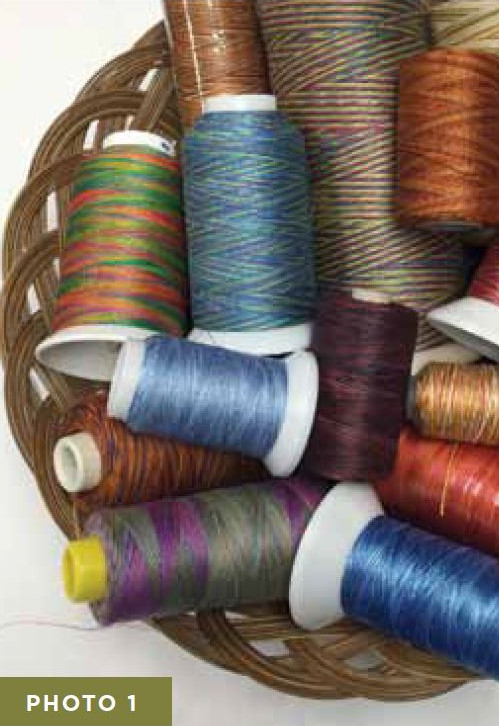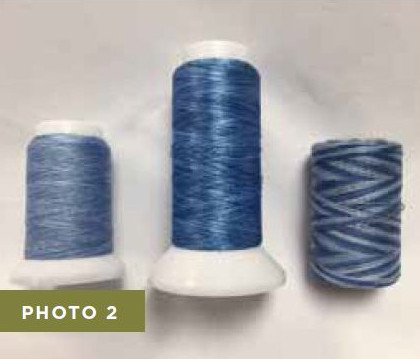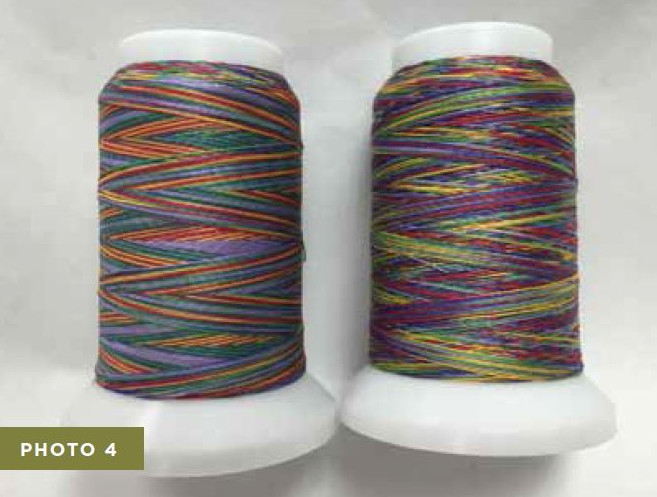Quilting the Quilt: variegated threads
Let the blending of Autumn colors inspire your quilting. Why choose one color when you can have a multitude?
“Crispy” is a great word to describe the autumn season. Crispy leaves of many colors fall to the ground and crunch under our feet. Crispy red apples drizzle juice down our chins with a single bite— or they end up in a delectable apple “crisp!” Tired flowers, empty fields and harvested gardens turn brown and crispy. Even the mornings and evenings are cool and crispy, coaxing us to put a quilt on the bed and snuggle under the warm covers.
The rich fall color palette that Mother Nature inspires wonderful quilts in gold, red, brown, green, yellow and orange. With all these colors blending together like a freshly raked pile of leaves, it’s hard to choose just one thread color for a quilt— especially if we have chosen an overall design.
Variegated thread might be just the answer! When variegated thread first started appearing in the market, the color selection was limited. You’d be lucky to find more than a dozen variations. Over the past decade that number has expanded to hundreds of color mixes, yet when you combine the three colors of light (red, green and blue) in different percentages over 16 million colors are possible!

Imagine what a tough time thread companies have trying to select which ones to incorporate into a single cone of variegated thread! One variegated
option includes cones that represent several different shades of a single color. Yet even that seemingly simple colorway can have a multitude of
possibilities. Take a look at the three different cones of blue variegated thread shown in Photo 2.

Some cones may go from dark navy to pale baby blue, while others keep the contrast to a minimum by keeping the values and shades very close and subtle. Other variegated threads highlight seasons, events and holidays. Is that pile of crispy leaves in your front lawn inspiring you to make an autumn themed quilt? Rest assured you’ll have a plethora of variegated choices in brown, orange, red and gold. Got a baby due in your family? You’re sure to find variegated thread in shades of pink, blue, yellow, lavender and mint green—and you’ll also discover some cones that blend all of those colors in the event you don’t know if a boy or a girl is on the way. Making a picnic quilt for the Fourth of July? Red, white and blue variegated thread will put you in a patriotic spirit!
Despite all of the variety available today, don’t be disappointed if you can’t find a cone that exactly matches the colors in your quilt. In fact, just because you can find variegated thread that matches the colors in your quilt does not mean it is the right choice.
Check out Photo 3, which shows a thread that moves from very light beige to dark brown. On the busy print on the left the thread blends pretty well with all the fabric’s colors. However, on the mottled brown fabric on the right, the light sections of the thread are very bold while the dark section disappears completely—especially when it falls on a darker shaded are of the fabric.

To help determine if variegated thread is the right choice on your project, find the darkest and lightest fabrics in your quilt. Then puddle the thread across them making sure you also put the lightest thread across the lightest area of your quilt as well as the darkest areas in the quilt. Do the same for the dark sections of thread. You’ll want to find out if the thread blends in too well (which can make it look like you forgot to quilt sections of the quilt) or if it stands out too much (which will make people want to step up to your quilt and pick off what they think are random stray threads!) The best
choice is one where you can see a little contrast between the thread and fabric no matter where it crosses.
When you’re shopping for variegated thread be aware that the way it winds on the cone can fool you into thinking you’re looking at two completely
different colorways. Take a look Photo 4. Both cones on are identical colorways—Superior Threads King Tut #918 Joseph’s Coat, yet the cones look
completely different. Double check labels when stocking up so that you don’t end up with two cones of the same color by accident, thinking you were getting two different colorways. Check with the store owner to see if you can open the package of thread before you buy it so that you can get a truer idea of the color changes.

While you’re at it, examine the frequency of color changes. Some threads change colors quickly—as often as every inch or so. Others may not change shades for six inches or more. Longer color segments may be fine on a busy quilt or with larger quilting designs. However, it could also make the quilting look splotchy if large concentrations of one color dominate the quilt or your quilting is denser in certain areas and may be magnified if there is high contrast among the thread colors. Photo 5 shows three different threads that each have similar shades of autumn colors. However, the distance between color changes is different for each.

For the top set of leaves in Photo 6, the color change happens every 4-5 inches. The thread on the center set of leaves changes every 3 inches, and
the thread on the bottom set changes every inch. There isn’t a “right answer” when choosing thread based on color change frequency—it is a purely
personal design choice.

Thread thickness and composition are two more variables that you should consider before choosing variegated thread. Thicker 40 and 30 weight threads leave a bold quilting line on the fabric. If you’re after texture and you want the thread to really stand out above the piecing, that’s fine. But if you’re looking for a blending element that pulls the quilt together while remaining subtle then stay at 40 – 50 weight thread or thinner.
Also be cognizant of how the thread type will interact with your quilt. For example, a thicker variegated cotton thread looks luscious on the cone
but it may not cooperate if you are quilting through densely woven batik fabric and cotton batting. Otherwise you may have more frequent thread
breaks since the thicker thread can’t slide through the needle eye or fabric hole easily. In that case, see if you can find a smooth polyester thread in a
similar colorway.
Variegated thread can open up a new dimension to your quilting by adding richness and shading similar to what the eye sees in real life. Your quilting machine is your paint brush and the thread is your medium. You can lay it on thick or spread it thin, make bold strokes or blend it in. Just be forewarned—collecting variegated thread can be just as addicting as collecting fabric. And if you are anything like me, you’ll become addicted to both!



